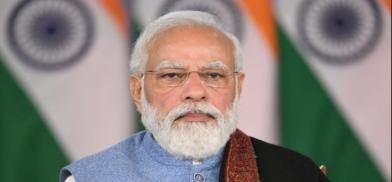Modi's silence on atrocities against minorities is disturbing
Modi's singular aversion to media engagement starkly contrasts with the active media engagement of leaders like Australian Prime Minister Anthony Albanese's one year in office. A notable analysis of his public relations strategy (Sydney Morning Herald, 20 June) reveals his tireless efforts to engage the public.

Democratically elected leaders must pass one litmus test regardless of their ideological inclinations: To engage the public and media to foster accountability and transparency. This imperative nurtures inclusivity, democratic values, accurate information dissemination, feedback, and ultimately, the trust and legitimacy bestowed upon leaders by the people they represent.
Over his nine-year tenure, Indian Prime Minister Narendra Modi has avoided press conferences, instead favouring a handful of pre-scripted interviews with sympathetic media outlets. Even during foreign visits, he restricts joint press conferences to predetermined questions. A telling example is his recent visit to the US, where he approved a pre-scripted interview with the WSJ and participated in a joint press conference with President Joe Biden but only allowed two scripted questions.
Modi's singular aversion to media engagement starkly contrasts with the active media engagement of leaders like Australian Prime Minister Anthony Albanese's one year in office. A notable analysis of his public relations strategy (Sydney Morning Herald, 20 June) reveals his tireless efforts to engage the public. Albanese held 172 press conferences, gave 89 TV interviews, and appeared in 128 radio spots. He actively interacts with right-wing, Trumpian-clone media outlets that vehemently oppose him.
Modi's isolationist, public engagement style eerily mirrors that of 20th-century autocrats, who manipulated the state-controlled and private print media both overtly and covertly to shape public perceptions and control information flows.
Unlike democratic leaders
Stalin maintained an aura of authority and distance from the public, restricting himself to carefully stage-managed events and crafted speeches devoid of any expression of emotion.
Hitler had a more visible presence in public, recognising the value of personally ignited propaganda and media manipulation to consolidate his power. He conducted large public rallies controlled by stormtroopers, during which he interacted briefly with the media using scripted Q&A lines.
Mussolini's Ministry of Popular Culture controlled media content and ownership. Mussolini left no doubt about its aim: To portray him as a charismatic leader. It suppressed all unapproved content. He also understood the value of public spectacles and mass parades, leveraging state-controlled media to amplify his passionate oratory.
Modi's behaviour is an amalgam of these approaches. It has nothing in common at all with modern democratic leaders' practices.
Modi relies on monologues, not dialogues. He avoids open and unscripted interactions with the media, preferring Venezuela's late autocrat Hugo Chavez's model of delivering weekly hour-long radio broadcasts called "Man ki Baat" (Reflections of My Mind). He organises massive rallies where party supporters are bused in (often paid) to listen to his scripted monologues. (The camera angles conceal the fact that petals are being thrown from within the motorcade itself, creating an illusion of public adoration.) Moreover, he insists on appearing alone in public pictures.
And he relies on silence on crucial social issues. Thus, he cannot be charged with anything! Modi has not uttered a word on the atrocities committed by his Hindutva acolytes upon Muslims, Christians or lower castes! This contrasts with leaders like former New Zealand PM Jacinda Ardern, who displayed great compassion for the Muslim community after the 2019 Christchurch massacre.
Tame and subservient media
Influenced by Modi's friends, the mainstream media channels, popularly labelled as "Godi Media" (lapdogs), suppress or manipulate unfavourable statistics and events. Well-oiled BJP and government machinery troll opposing views on social media. Official economic and social indicators are often doctored.
But here is the rub. No, India is still not ruled by a fascist because no autocrat or would-be dictator can control the free-wheeling mind of "The Argumentative Indian" (Amartya Sen). The provocative economist Joan Robinson pronounced one immutable truth about India in 1954: "Whatever you can rightly say about India, the opposite is also true".
This adage also holds true in this case: Whatever Modi's spin doctors do to shape public perceptions through manipulating mainstream media, the street level often has different views.
India boasts a vast and diverse media landscape, with 144,000 registered newspapers and periodicals, including 299 mainstream dailies and over 300 weekly magazines. There are some 700 million internet users and 600 million smartphone owners.
On top of that, Indians are more avid readers – 10.42 hours per week per person – than any other people.
Hinduism advocates inclusivity
But, there is little doubt that Modi's silence on the subliminal and physical atrocities committed by his Hindutva supremacists is fraying the very quintessence of Hinduism, which, ironically, they claim to defend. At the same time, it also discourages those who wish India to return to the democratic path, which, equally ironically, Modi himself described to the US Congress as being in "our DNA".
Hinduism advocates inclusivity, a live and let-live attitude without any prescriptive commandments or prophets that plague the Abrahamic religions.
The net effect is collateral damage to the idea of India, not unlike what the Taliban and their alike have wrought on Islam.
And yet some solace is to be found in the Tibetan saying: Men say that time passes; time says that men pass.
So shall Modi.
(The author is a former Australian diplomat and founder, www.DownloadingMyMind.com. Views are personal. He can be contacted at rakeshahuja@axessindia.com)









Post a Comment